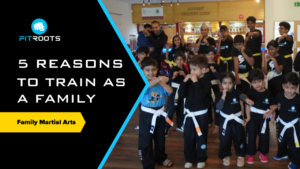If you are thinking of joining a Martial Arts School, it’s key to understand what the key signs are of a bad place, before you attend.
We want you to be aware of these signs before it’s too late.
On the positive side, you will be armed with the right knowledge. You will be ready to commit to your new Martial Arts journey, with the right Martial Arts School.
Your first Martial Arts class should be really interesting and extremely exciting.
However, most people have the perception that when they go to their first class, it’s either going to be old school dojo, like ‘Fight Club’, and they might get beaten up.
Or it’s going to be like Karate when you were a kid. Where you end up practicing endless forms and katas in the air for nothing.
We wanted to make sure you know the top five signs to look out for so you can save money, time, energy, and make sure you’re safe.
https://www.youtube.com/watch?v=v_tfQWoBz6w&t=25s
1 – Martial Arts Black Belts – Are They Real?
Sign number one is Black Belts. Lots and lots of Black Belts, and Black Belts being given out to kids.
Unfortunately, these days we’ve seen Black Belts being given out to young children (i.e. even children under 10 years old).
They shouldn’t have them.
Here’s what to look out for:
- If it’s taken them a short amount of time to get it, then you know it’s probably not legitimate.
Is It Ethical To Have A Fake Black Belt?
Let’s imagine a child under 10 years old. They have most likely practiced Martial Arts for five years (at a maximum). And they have probably been training a few times a week for the privilege.
Next, if they’ve received their Black Belt, and they’re not really that competent, i.e. they aren’t actually able to defend themselves, it’s really not that ethical.
Think about it. As a student, or as a parent of a student, would you want to be given a real Black Belt, or a fake one?
Hopefully the answer is the real one. Remember, the real one in a real school takes time. Just like anything in life, it should be earnt.
A Black Belt should denote a clear sign of mastery. That is, the mastery of Martial Arts, both physically and mentally.
For a beginner, understanding the fundamentals of Martial Arts takes a few years. Let alone being able to receive one of the supposed highest accolades in Martial Arts within the same time frame.
For some, the physical development can come quicker than others. But for most, the mental development is what requires time. Think about how different you are now in character, compared to five, and even 10 years ago.
Now, apply the same thinking to your potential Martial Arts journey.
See that in those time frames, you would be at best of Intermediate ability after five years of training, and potentially of Advanced ability after 10 years of training.
Many Martial Arts Schools give out Black Belts freely. This ensures the kids or the adults (or even the parents) stay motivated. That’s to keep training and paying their membership fees.
Can You Actually Defend Yourself?
But the problem is, once they receive that Black Belt, they realise that it’s a waste a time and money. Because it doesn’t result in real, practical self-defence.
The fundamental problem here is a lack of morality.
Particularly from the Martial Arts Schools who give Black Belts to people who don’t deserve them. They have placed profit above transparency and reality.
A simple example of this lack of morality would be, if said Black Belt student had unfortunately got into an altercation.
They would not be able to defend themselves. And may actually come off worse, than if they didn’t have the bad Martial Arts training in the first place.
Tip
The sign mostly says it all, that is, look out for loads of Black Belts!
However, the other indication is that the content being taught in the classes is not that practical. If you see Black Belts performing techniques, and you think, “I could do that…” (assuming you have no Martial Arts experience), then steer clear.
2 – Frequent Gradings
Sign number two is gradings, and that’s lots of gradings.
So, just like sign number one, you want to make sure that students aren’t being progressively graded every single year. Or even worse, multiple times a year, especially if they haven’t earnt it.
How Long Does It Take To Get Your Black Belt?
When children have Black Belts, they normally receive them within two to four years.
But in any reputable place, it will take at least six to 10 years for a student to receive such an esteemed grade. The reason why this is done though is just to keep people around, and to make sure that students pay for multiple gradings either throughout the year, or every year.
It’s worth noting that most Martial Arts School have a different syllabus and/or grading structure.
For the majority (even the bad ones), to reach Black Belt, students would have to go through a series of belts beforehand. It’s hard to say exactly how many, as everywhere differs.
But on average, let’s say it’s 10 belts from White Belt (starting belt) to Black Belt.
Now, let’s assume that within the space of four years, that’s at least two gradings per year, or roughly one every six months.
In any reputable Martial Arts School, the instructors know that progression can be made in such a time frame.
However, it’s much more beneficial for the student to wait until they are unquestionably ready to grade again.
To take the example of a child getting a Black Belt; if they started at six years old, by their 10th birthday, they could have already mastered Martial Arts.
Or at least that’s what they’ve been told, directly, or indirectly.
Follow The Money…
To tie this back to, ‘follow the money’, gradings are normally an additional fee.
And understandably so, as there is a lot of work put into them. However, let’s just conservatively say each Grading is £25.
By the time you reach Black Belt, you will have spent at least £250 just on the progression of belts within four years.
Whilst this doesn’t seem that expensive, what’s worse is wasting time, and realising that your training is not bounded in reality.
Tip
Before joining a prospective Martial Arts School, ask to look at their Grading Syllabus.
Also, ask what the general time frames are for grading intervals. If the intervals are too short, you will know to avoid them.
If they are longer intervals, I.e. nine months – one year +, then you are potentially in the right place.
3 – No Martial Arts Mental Teachings
Sign number three is that you’re not taught about any of the mental aspects of Martial Arts.
By definition, Martial Arts means the ‘art of war’. So, actually you can’t just focus on the physical, or the war like part.
You must also focus on the arts, which is the mental side, the Philosophy and the Psychology.
How Does The Mental Side Apply To Real-Life Situations?
What most people who understand Martial Arts and self-defence know already, is that if you do ever get into a situation, you have to know how to stay calm.
You have to manage your emotions so you can be aware of yourself, and your surroundings.
That will only come once you understand the philosophical aspects of Martial Arts.
Marital Arts are inherently tied (historically) to Philosophy and Psychology.
The best Martial Artists are the ones who master their mind and body.
You’re not just going to learn how to kick and punch; go to a place which serves both your mental and physical development.
Who Is Mental Development For?
Mental development and training is not for everyone, and it depends on how you want to be taught, and what you wish to learn.
Some students wish to simply learn the physical parts of Martial Arts, expecting that to be enough for them to build a solid foundation.
Others realise the depth of the mental teachings is just as important as the physical teaching.
Which side you fall on depends on your intention, you can read more about this in our Top 7 Martial Arts Problems and Solutions blog here.
Why Is It Bad To Not Be Taught The Mental Side?
Now you know why it’s important to study the mental parts of Martial Arts, you might be wandering why it’s a sign of a bad place, if they don’t teach you it.
There are many reasons, but fundamentally it’s two things. Either:
- The instructors do not value the mental aspects
- The instructors do not know what the mental aspects are
Let’s take each reason individually…
The instructors do not value the mental aspects
If the instructors do not think it is important for students to learn about the mental side of Martial Arts, the immediate question should be, ‘why?’.
In the Martial Arts world, this is a classic case of, their instructor didn’t teach them, so why should they teach it to their students?
There is an unspoken tradition of keeping things the way they have always been.
Even though this has some positives, it doesn’t always lead to evolving syllabuses for students like yourself.
Ultimately, it’s harder to value something if you can’t see how it will directly apply to your life.
The instructors do not know what the mental aspects are
This is linked to the first reason, where the instructors weren’t taught about the mental teachings.
Here we see that the Martial Arts industry (in the majority), does not take the time to develop themselves outside of class.
Let’s take a hypothetical scenario of someone sparring for the first time, where they are scared that they will get hit.
Of course, this scenario is highly likely, and can be daunting if the sparring is not controlled.
However, do you think that the student acquiring the skill to evade the hit, and retaliating with their own is purely physical?
Or is it at least somewhat mental too?
To overcome the fear of being hit, is not an overcoming of the self in a purely physical sense, but a mental empowerment that comes from understanding one’s own limitation and potential.
Tip
If you are purely focused on learning just physical Martial Arts, then find a school which teaches pure techniques, and does frequent sparring.
If you are open to developing mentally too, find a school which has a balance between physical and mental developments. This should be reflected in their classes, and in their Grading Syllabus.
4 – What’s The Student to Instructor Ratio?
Sign number four is student to instructor ratio.
This sign entails lots of students to not enough instructors.
Let’s see where this comes from…
What Is a McDojo?
There’s a term in the Martial Arts industry called ‘McDojos’, and it’s just a funny play on the name McDonald’s.
In essence, it’s really bad places which teach fake, illegitimate, and/or extremely bad quality Martial Arts.
They can get you into some serious trouble.
What’s The Problem With The Student To Instructor Ratio?
A big problem with the wrong student to instructor teaching ratios is that in McDojos, you will have only one instructor teaching lots of students.
Normally, in a good Martial Arts School, this might be ok, as the level of instruction from the students and instructors is high.
However, in a McDojo, the problem multiplies, as you have bad instructors, and bad students teaching other students incorrect methods.
On many occasions, McDojos also recruit students into their ‘instructor training programme’, when they are far from ready to begin teaching others.
These recruits are passing on their lack of knowledge, to other paying students, who then embed bad habits in their style too.
If you don’t know how to correct yourself, how to apply the techniques, what will happen is that eventually class after class, month after month, and year after year, you won’t get that much better.
So, you want to make sure that you’re in an environment where the students and your friends are either at a similar level to you.
Or you’re working with similar partners as you, as you go through your classes.
Possibly the worst part of this is that even though you’re not learning legit self-defence and that’s a problem in itself, you’re not being corrected.
Also, if you don’t know how to use your body in the right way, it could potentially lead to injuries, dysfunctions, and further problems down the road.
You’ll want to make sure those are stopped right here and right now.
Tip
A McDojo is easy to spot from far away when you know what to look for.
Look out for students who shouldn’t be teaching others yet, and see if the main instructors’ skills and teaching style can actually teach you genuine Martial Arts.
You can read more about how the student to instructor ratio effects your Martial Arts journey here.
5 – Is It Practical?
Sign number five is practicality.
You obviously want to make sure that what you’re learning could genuinely work if you had to use it in a real-life situation.
There are some key telltale signs here.
One way you can really see that what you’re learning is not that practical, is that whenever the techniques or the combinations are being demonstrated, they’re only being used on students who are compliant.
Compliant students tend to be chosen by the instructor.
These are normally students of higher rank, and who have been around for a while.
Said student tends to completely relax when the instructor is demonstrating the technique, and not give any ‘real-life resistance’.
Yes, techniques should be shown slowly and with caution explaining each part.
But there should also be a demonstration with a ‘live element’. Where there is genuine resistance being given, to prove that it works in reality.
You must make sure that what you’re learning is practical, effective, and if you ever had to use it, you would be able to do so in a safe and effective manner.
How Should Techniques Be Taught?
On top of this, what you’ll find is when these arts or Martial Arts Schools aren’t practical, they’ll also perform techniques in set patterns.
Before explaining fully, this is not a criticism of Katas, where they have forms, which is a set sequence of movements practiced in the air.
But when someone says, for example, “if someone does X you do Y.”
E.g. “If someone punches you in this direction, you do this block to avoid being hit.”
The problem is reality just doesn’t work like that.
Reality is not going to tell you what’s coming at you.
You’re just going to have to adapt to what is in front of you. And the only way you can do that is if you’re ready for any and every situation.
Your training should be a mixture of static and dynamic scenarios.
Set drills, which are a specific sequence of exercises, are used to primarily train the neuromuscular connections in your body and mind.
These tend to be static by nature.
Then, the dynamic scenarios are essentially putting your techniques into practice.
Testing to see if they would work in a real-life situation.
A typical example of this would be sparring, which is live practice of your techniques on partners in a controlled environment.
McDojos tend to only practice in static scenarios. Others focus on a mixture of both.
If you are learning Martial Arts for self-defence, this sign should be at the top of your mind.
Tip
Assess the Martial Arts School you are thinking of joining, to see if they teach practical Martial Arts, where they drill techniques in both static and dynamic scenarios.
If they do both, you can at least see that they are attempting to teach you Martial Arts that works.
If you only ever see students practicing statically, you may think to yourself, ‘How would they ever make that work in reality…’.
Conclusion
So that’s the five signs to look out for in a bad Martial Arts School.
If you or your child are looking to get into Martial Arts, then you need to be aware of these five signs, so that you have a great learning experience.
We want to make sure that you have the best journey possible.
That’s starting Martial Arts right from being a beginner, all the way up to expert.
I’d love to know what your experiences are with Martial Arts schools.
Whether you’re a novice or an expert, and if you’ve witnessed or experienced any of these signs yourself.
Or maybe, you’ve never attended a class before, and want to know what else to look out for?
Also, if you have more signs which you think would be useful for other people to know, feel free to leave your comments and questions below.
I’ll personally get back to you to make sure we can engage in great conversation.
If you would like to learn from the team here at FitRoots, contact us today by visiting our Contact page here, or click the button below.
We will contact you within 24 hours, to discuss exactly what you need, and if we are a good fit for you.








